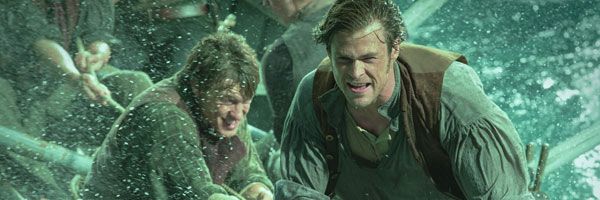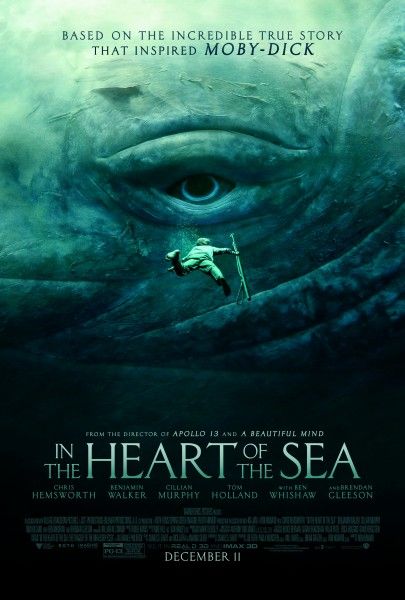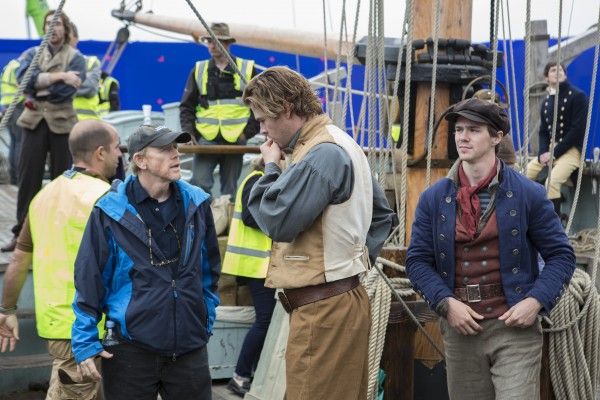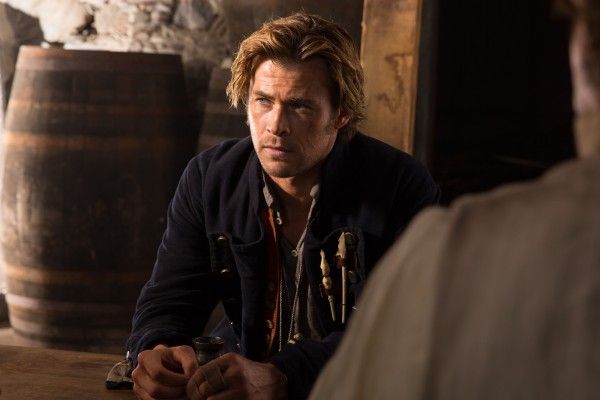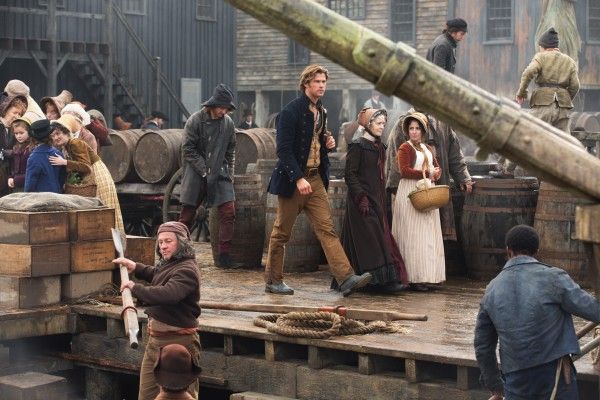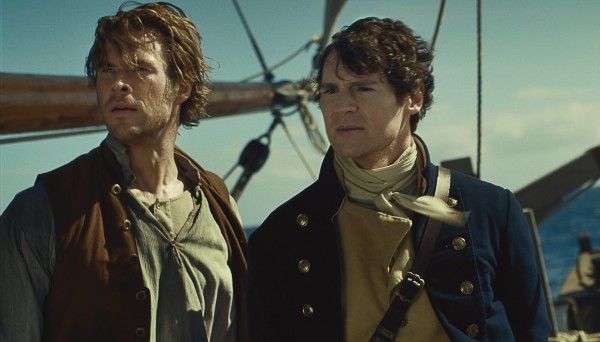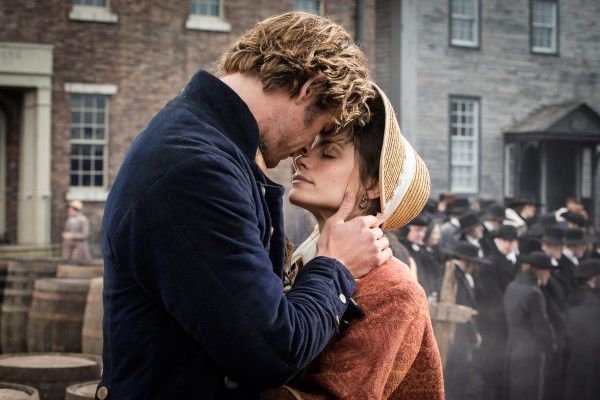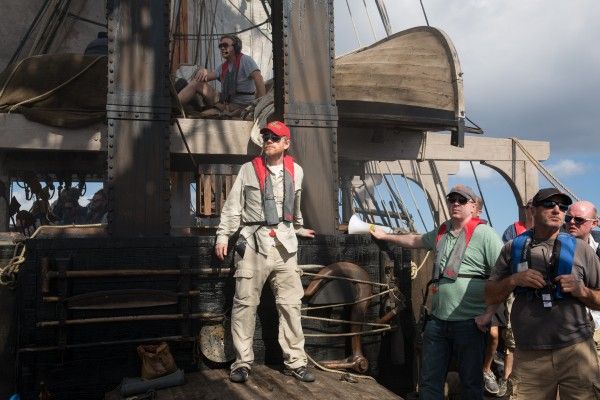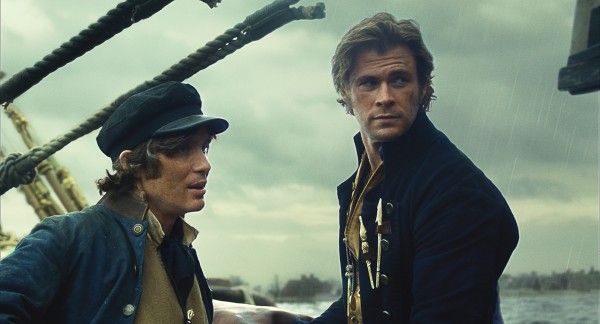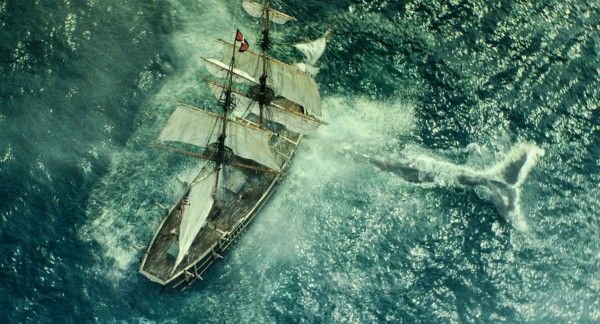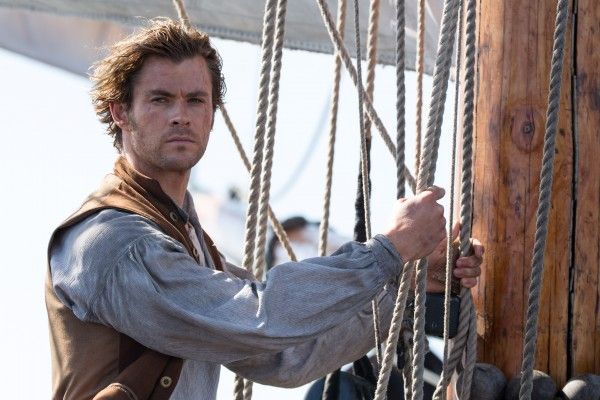In 1819, the whaleship Essex set sail from Nantucket with a 20-man crew on a voyage to hunt whales, whose oil was responsible for New England’s booming economy. What should have been a routine 1-2 year venture turned into disaster when a giant sperm whale attacked and sunk the ship, leaving its crew stranded on three small whaleboats with minimal navigation equipment and a very low supply of food and freshwater. When all was said and done, only seven survived the journey, as three months alone at sea led to starvation, infighting, and cannibalism. Author Herman Mellville was so shaken by the story that he became inspired to write the American classic Moby Dick—heavily influenced by the events of the Essex and its crew—and now director Ron Howard is bringing the tragedy of the voyage to life on the big screen.
In November 2013, I was invited to the London set of In the Heart of the Sea along with a handful of other journalists, where I was able to get an inside look behind the making of the film including discussions with Howard and his leading men, Chris Hemsworth, Benjamin Walker, and Tom Holland.
When I first arrived, it was instantly clear that Howard was taking an appropriately big approach to the film. On the backlot of Leavesden Studios in London, Howard had crafted a massive recreation of early 19th century Nantucket, complete with cobble streets, doors that open to fully dressed sets, and most strikingly, an honest-to-goodness harbor with water and a life-size ship waiting at the dock. This is the kind of clout that a filmmaker of Howard’s stature buys, and the production value was extraordinary.
Below, I’ve compiled a brief list of some of the highlights I learned from my visit, followed by a much more in-depth and thorough account of my time on set.
- Producer Paula Weinstein began development on the film 14 years ago with Barry Levinson.
- As a tribute to the “American Novel”, the filmmakers decided to make Herman Melville a character in the film, opening in 1850 and then flashing back. The flashforwards are weaved throughout the movie.
- Cinematographer Anthony Dod Mantle was fond of hiding small cameras throughout the set of the ship, so the actors never truly knew when they were in the frame or not.
- Visually, Howard wanted the film not to feel traditional, but instead like a historical documentary. The film’s production designer specifically cited Deadliest Catch as an influence.
- Howard compared the appeal of the film to the appeal of Rush, saying both movies offer the possibility of transporting audiences in a very cinematic, modern, compelling way.
- Howard describes the film as one of emotional transformation and how individuals cope with tests.
-
Chris Hemsworth was instrumental in getting Ron Howard onboard as director after their work together on Rush. - Howard’s frequent collaborator Peter Morgan came on to do a revision draft of the script, whose contribution producer Paula Weinstein says was “substantial”.
- They shot a prologue for the film involving Jordi Molla and another, separate ship being attacked by the same whale, which was described as being in the vein of Jaws.
- The outdoor set was first used to shoot the Essex on the open sea, acting as a giant water tank. It was then stripped and transformed into Nantucket, with a 250 meters squared water tank acting as the harbor.
- There’s an entire color spectrum for the water over the course of the film.
- The cast worked their way down to eating just 500 calories a day, under the supervision of a nutritionist, so that they could embody the starved physicality of the characters.
- Tom Holland had a couple of sessions with Brendan Gleeson, who plays the adult version of his character, so that they could create a similarity in their accents. Additionally, Holland watched videos of Gleeson’s other performances to try and pick up on some of his characteristics.
-
Hemsworth wrapped Blackhat 24 hours before beginning filming on In the Heart of the Sea, during which he was also partaking in the press tour for Thor: The Dark World.
- The actors ate real hardtack, which is a bread-like substance that the real Essex crew subsisted on.
- The film ups the drama between Hemsworth’s Chase and Benjamin Walker’s Pollard, putting Holland’s Nickerson in between the two. They’re at conflict with one another from the get-go, but there’s also an underlying respect.
- The visual effects team worked with a couple of universities ot understand how whales move and how they act in order to realistically portray the sperm whale.
- On set, they referred to the whale as “Moby”.
- The film uses mostly CG to render the whales.
- They spent five weeks shooting in the Canary Islands, with only two sequences on land. The rest were scenes shot on the lifeboats.
Background
The doomed tale of the Essex was so legendary in the 1800s that one could hardly grow up in America without hearing about the voyage—it was the Titanic of its day. A few first-person accounts of the events were recorded by the surviving members of the crew, and these were compiled into author Nathaniel Philbrick’s bestselling non-fiction book In the Heart of the Sea, which is the basis for Howard’s film. The attack of the Essex by an enraged sperm whale came as a shock to the world, as the whaling industry had been booming for years with not one single account of a whale actively seeking out and ramming a ship.
When the Essex was destroyed, it was in the middle of the Pacific ocean and thousands of miles away from any known land. The crew was forced to outfit its small whaleships—normally used to engage, kill, and tow whales back to the main ship—with sails and brave the open sea in hopes of catching a wind that would draw them east to South America. The voyage became exponentially worse as the days turned into weeks and months and the crew slowly started succumbing to the effects of starvation. The first members to die were reluctantly eaten, and towards the end of the voyage one of the whaleships decided to “draw lots” in order to see who would be killed and eaten—there was no longer time to wait for someone else to die.
The harrowing voyage of the Essex was lead by the noble but somewhat insecure Captain Pollard, played in the film by Benjamin Walker. His first mate Owen Chase, played by Chris Hemsworth, quickly became a de facto leader of the group, as Pollard was reluctant to make decisions and remained unsure of himself for most of the voyage. One of the survivors of the voyage was cabin boy Thomas Nickerson, played by Tom Holland (The Impossible), and the film is told from his perspective. There is also a frame story element to Howard’s pic, as Brendan Gleeson plays an older version of Nickerson who reluctantly recounts the events of the voyage to a young Herman Melville (Ben Whishaw), who in turns finds the inspiration he’s been so desperately seeking.
The Set
When we first arrived at Leavesden Studios in London, we were instantly transported to early 19th century Massachusetts. Howard constructed a massive set of the harbor at Nantucket, complete with a full ship submerged in water, shops, a blacksmith, a bank, a pub, and 250 period-specific extras. The streets were riddled with mud and I had to watch my step in order to avoid running into the trio of horses that were being led around—the attention to detail by Howard and production designer Mark Tildesley was astounding. Every nook and cranny was painstakingly crafted to look like it belonged in the early 1800s, and the dreary London weather only added to the air of authenticity.
Following the Nantucket street out onto a dock, we were lead to a massive whaleship replica of the Essex built to scale. The boat was docked in the harbor, which itself was filled with water thanks to a significantly large tank that Howard had constructed on the backlot. 100 feet out or so was a platform rigged with electronics, where one of the crew members was operating a giant piston that would push down into the water and rise up again, creating sea-like waves throughout the tank which in turn rocked the ship.
We were told that weeks before, this outdoor set lacked any of the Nantucket portions and was used to film the giant whaleship on the open sea. The Essex replica was attached to a gimble underneath the water, so Howard was able to rock the boat back and forth and shoot water cannons at it, thus capturing some of the many, many hardships that plagued the ship’s crew.
The Filming
The scene we saw being shot was one of the last in the film, as the surviving members of the crew return home to Nantucket, skinny and bruised by sunspots. In addition to directing his lead actors, Howard also had to manage a very large crew of extras. Moreover, In the Heart of the Sea marks the filmmaker’s second collaboration with Oscar-winning Rush and Slumdog Millionaire cinematographer Anthony Dod Mantle, and Mantle’s ambitious style of shooting meant that the camera could be anywhere at any time. The film’s unit publicist informed us that Mantle had become fond of hiding small cameras all over the set, so the actors were never entirely sure that they were out of frame. Mantle’s past work has shown incredible creativity, including the “helmet cams” in Rush and the exhilarating handheld style of Slumdog Millionaire. I’m incredibly eager to see what he cooks up for this period sea-set tale.
Howard was taking an atypical approach to the visual style of In the Heart of the Sea. Instead of opting for a more traditional, cinematic feel to the film, Howard and his team wanted the pic to feel almost like a historical documentary—production designer Mark Tildesley specifically referenced Deadliest Catch. Howard wanted to capture the tale of the Essex in a raw and visceral fashion, putting the audience right in the middle of the voyage.
Not only is Howard going for a bold aesthetic choice on In the Heart of the Sea, but his actors also had to undergo serious physical transformations. In order to adequately portray the Essex crew’s starvation, the pic’s stars underwent a rigorous low calorie diet under the supervision of a nutritionist. Hemsworth, whose Marvel sequel Thor: The Dark World had opened in theaters only a day before we arrived on set, was nearly unrecognizable—and he was only at the beginning of his weight dropping regimen. The production was towards the end of its filming on the London sets and soundstages, and in a matter of days they would be moving down to the Canary Islands to do five weeks of location shooting. It’s here that Howard would capture the crew at their lowest points on the open sea, when the lack of food turns them into walking skeletons.
The young Tom Holland told us that their diet consisted of zero carbs, and as a result of the lack of food all of the actors were extremely tired and, at times, a tad irritable. Hemsworth, Walker, and Holland were in good spirits when we spoke to them and couldn’t have been nicer, but Hemsworth understandably seemed rather exhausted—the fact that he had just flown in from the U.S. premiere of Thor the day before probably didn’t help matters.
We also briefly got a look at the filming of another sequence from the film, which was being overseen by VFX supervisor Jody Johnson while Howard was occupied with the extras-heavy work on the Nantucket set. We walked into a soundstage hosting a tank and were immediately unable to see through the dense steam. Johnson was shooting a sequence that he described as “a tone piece” that will open the film, involving a Spanish ship and its unlucky crew. He played coy with the specifics of the scene, but when asked if its relation to the rest of the film is similar to the opening of Jaws, he replied in the affirmative.
On the monitors, we saw Jordi Molla under the water looking past the camera at a terrifying sight. We overheard talk about whether to outfit Molla with a blue sleeve on his arm, leading me to believe that this prologue will involve a rather violent attack by some mysterious sea creature.
All in all, the pure craftsmanship on display at the In the Heart of the Sea set was stunning, and while the performers were understandably exhausted, all seemed happy to be bringing this specific story to the big screen.
For more of my coverage from the set, peruse the links below. In the Heart of the Sea opens in theaters on December 11th.
- Chris Hemsworth on 'In the Heart of the Sea', Losing Weight, Ron Howard, and More
- Tom Holland on 'In the Heart of the Sea', Working with Thor, and More

